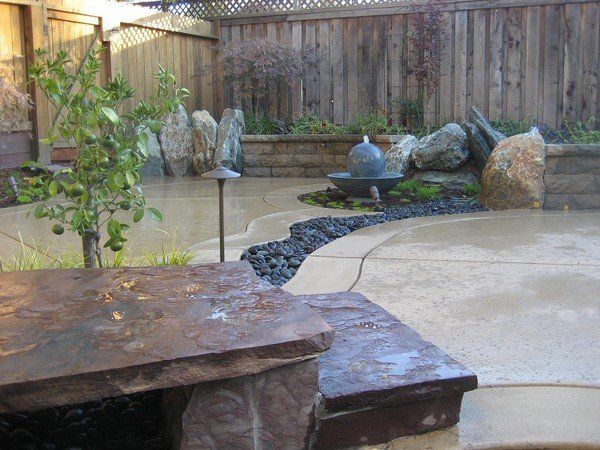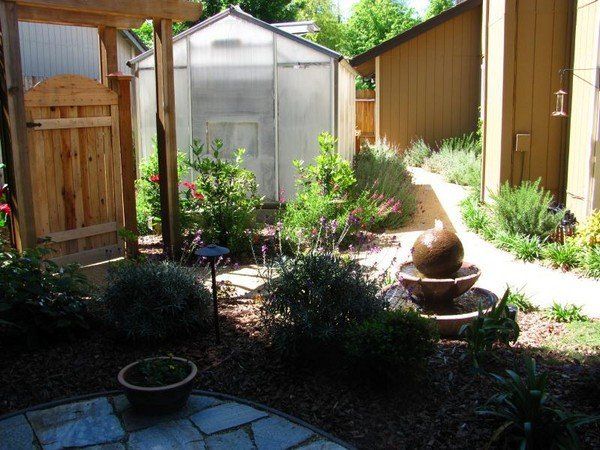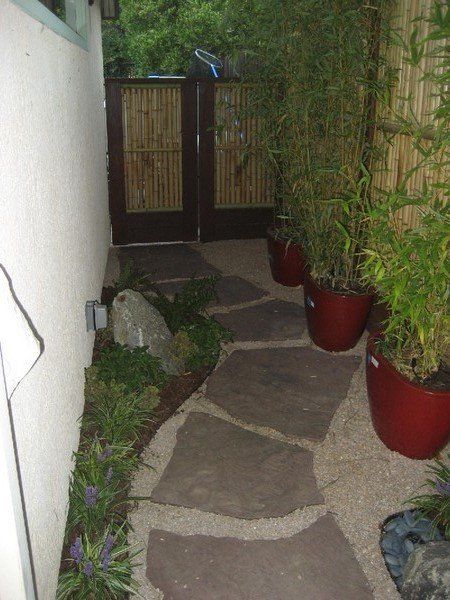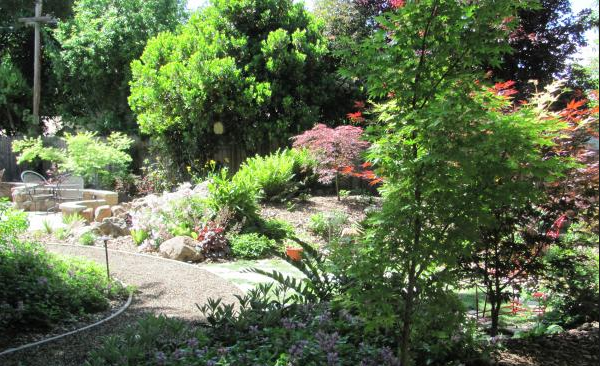Small backyard becomes Asian garden
- By Susan Silva
- •
- 09 Sep, 2014
- •

Going into the job, I knew this small backyard was in need of a complete makeover. The deck was old, worn and rotting. The brick patio and planters were falling apart. The spa always needed maintenance and wasn't being used. The backyard also needed screening from fences, high rise wires and the westerly sun.
I designed this new backyard to one with an Asian flair. The low curved walls and boulders retained the raised planter beds while offering additional seating. The inset black pebble river pattern meanders from the subtle fountain and passes under the stone bridge. As done in Asian gardens, boulders were chosen for their shape and placed to convey different feelings. A vertical tall stone, two to three times taller than its width, creates a sense of excitement. A medium stone gives the impression of rest and relaxation and a stone, low and hugging the ground suggests peace and tranquility.
The new curved concrete steps and seating areas made optimum use of space while also adding depth, interest and creativity.
Concrete, like carpet and other floor coverings come in every color and pattern imaginable. In my opinion, the simplest patterns and neutral colors are best. In Asian gardens especially, the hardscape should be subtle and natural in color so the eye is drawn to the plants, trees, boulders and garden accessories. Concrete costs much less than most other hardscape materials and is durable, requiring little if any care.
The Asian flair was also achieved with the plant selection. Japanese maples, espaliered citrus, Clematis vines, jasmine, dwarf pines, espaliered Camellias, ferns, Japanese forest grass, lily turf and bamboo are part of the planting theme and will soon fill in and mature. The planter beds were generously amended so that the plants will grow and thrive. The vines and especially the trees will provide the dense privacy, shade and screening.
Many of the plants chosen will also draw in birds. The birds will also enjoy sitting on the fountain rim and playing in the cool water. Yellow finches and robins are just some of the birds drawn to this garden.
A vertical garden was also attached to a sunny fence for seasonal herbs, vegetables and flowers. So often clients want to grow these plants, but don't have enough if any sunny space for raised beds on the ground. Vertical gardens are functional, easy to manage and a creative focal point in the garden. They don't require space while also doing the job of covering part of a fence or wall. A typical fence section measures 6 feet by 8 feet which equals 48 square feet of gardening space. Just imagine, two vertical gardens provide 96 square feet of gardening space.
Whether your backyard is large or small, you would be amazed by how many other features can be incorporated when high maintenance items such as lawn and old wooden decks are eliminated. My clients frequently tell me that these new backyards are now their favorites because they spend their time relaxing in them rather than mowing, watering and maintaining them.
This landscape design was professionally engineered and implemented by Steve Irwin and his crew of Alpine Terrace Landscaping.

It will take thirty years to replace a thirty year old tree. A lawn can be restored in just a couple of months.
Kyle Floyd, with Green Acres Nursery reminds customers that it's the lawn that is the larger culprit for consuming water and not the trees. Unlike lawn, a majority of trees can withstand drought, but still need to be properly watered based on the tree's species and size.
It's essential to understand trees and their water needs. Most tree roots are in the top eighteen inches of soil, but studies show the greatest number of tree roots consuming water, oxygen and nutrients are in the top six to eight inches.
- A general rule is to use approximately ten gallons of water per inch of the trunk's diameter (width of trunk measured at knee level) for each watering. General formula: Tree diameter times five minutes equals total watering time.
- Example: When hand watering using a garden hose at medium pressure, it will take about five minutes to produce ten gallons of water. For a four inch diameter tree, it should receive forty gallons of water. Multiply by five minutes for a total watering time of twenty minutes.
- Distribute water evenly under the tree's dripline.
Water early in the morning or after the sun has gone down. These are the times when trees restore the water lost during the day. Also, be sure to add mulch around the trees to reduce soil temperature and decrease water evaporation.
Soaker hoses and drip systems keep the trees healthy while using less water. They soak into the ground where the water is needed, and not run into the street and drains. Long, slow watering to a depth of twelve inches with soaker hoses or in-line emitter drip systems buried below three to four inches of wood mulch is often recommended. Generally in warmer months, younger trees need to be watered twice a week, and most mature trees every two weeks.
Landscape contractor, Steve Irwin of Alpine Terrace Landscaping often advises using soaker hoses placed around the drip zone (area shaded) of the tree with timers. For extra large established trees like Sequoia sempervirens (Redwoods), Steve advises watering these giant trees with soaker hoses for a twenty-four hour period every two weeks in the warmer months.
An easy and inexpensive option for deep & slow watering for very small trees is to water them using a five gallon bucket. Steve Irwin recommends puncturing a very tiny hole at the the base of the five gallon bucket (thirty-second of an inch), place the bucket under the tree's drip-line, and fill to the brim with water. This method should be done twice weekly per small tree, moving the bucket (s) when empty to other spots within the dripline.
Trees provide shade and shelter to our homes and wildlife, and most importantly trees provide the healthy air all of us need to breathe. It's critically important for our health and environment to keep our trees watered, healthy, and producing oxygen.
According to chemistry expert, Anne Marie Helmenstine, Ph.D in her article, "How Much Oxygen Does One Tree Produce?", are the following quotes from studies made of different trees regarding the overwhelming importance about the oxygen our trees produce.
"One acre of trees annually consumes the amount of carbon dioxide equivalent to that produced by driving an average car for twenty-six thousand miles. The same acre of trees also produces enough oxygen for eighteen people to breathe for a year." - NY Times
"A mature leafy tree produces as much oxygen in a season as ten people inhale in a year." - Arbor Day Foundation
"On average, one tree produces nearly two hundred sixty pounds of oxygen each year. Two mature trees can provide enough oxygen for a family of four." - Environment Canada





